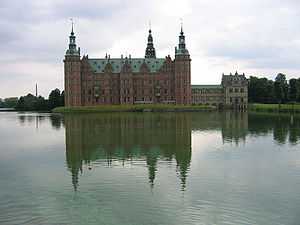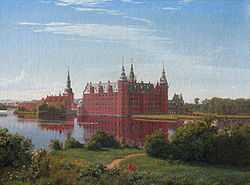Frederiksborg Palace

Frederiksborg Palace or Frederiksborg Castle (Danish: Frederiksborg Slot) is a palace in Hillerød, Denmark. It was built as a royal residence for King Christian IV and is now a museum of national history. The current edifice replaced a previous castle erected by Frederick II and is the largest Renaissance palace in Scandinavia. The palace is located on three small islands in the middle of Palace Lake (Slotsøen) and is adjoined by a large formal garden in the Baroque style.
History

The oldest parts of the castle date back to the 1560 structure built by Frederick II. Although he remains its namesake, most of the current palace was instead constructed by Christian IV between 1602 and 1620. He employed the Flemish architects Hans and Lorenz van Steenwinckel and the castle follows the Dutch style employed by Christian IV for his new buildings in Copenhagen.
After Christian IV's death in 1648, the palace was used mainly for ceremonial events. It was the scene of the following anointments:
- 1671: Christian V and Charlotte Amalie of Hesse-Kassel
- 1700: Frederick IV and Louise of Mecklenburg-Güstrow
- 1721: Anna Sophia, consort of Frederick IV
- 1731: Christian VI and Sophia Magdalena of Brandenburg-Kulmbach
- 1747: Frederick V and Louise of Great Britain
- 1752: Juliana Maria of Brunswick-Wolfenbüttel, consort of Frederick V
- 1815: Frederick VI and Marie of Hesse-Kassel
- 1840: Christian VIII and Caroline Amalie of Schleswig-Holstein
The church has also been used as the knight's chapel for the Order of the Elephant and the Order of the Dannebrog since 1693; housed the Danish royal family's art collection, notably works on the life of Jesus by Danish painter Carl Heinrich Bloch; and was the site of the 1720 Treaty of Frederiksborg.
In the 1850s, the palace was again used as a residence by King Frederick VII. While he was in residence on the evening of December 16, 1859, a fire destroyed a large part of the main palace's interior. Reconstruction was funded by public subscription, with large contributions from the king and state, as well as the prominent philanthropist J. C. Jacobsen of the Carlsberg Brewery. Jacobsen also funded the museum of national history[1] that now occupies Frederiksborg.
The Palace Church
The Palace Church or Chapel of Orders serves as a local church today and is a part of the museum on the premises. The coats-of-arms of recipients of the Order of the Elephant and of the Dannebrog are displayed on the walls of the church.
The Museum of National History
The museum houses an important collection of portraits and historical paintings.
Countess of Frederiksborg
Alexandra Christina Manley was created Countess of Frederiksborg (Grevinde af Frederiksborg) by Queen Margrethe II on April 16th, 2005, eight days after her divorce from Prince Joachim. The title refers to her marriage to the prince which took place in the Palace Church.
Gallery
-

Frederiksborg Palace by Lazarus Baratta, 1652
-

Frederiksborg Palace, by Christen Købke, 1835
-

Frederiksborg Palace by P.C. Skovgaard, 1841
-

Frederiksborg Palace church.
-

View from Hillerød town square.
See also
References
- ↑ "Det nationalhistoriske museum - Frederiksborg slot" (in Danish). frederisborgmuseet.dk. Retrieved 4 December 2010.
External links
| Wikimedia Commons has media related to Frederiksborg Slot. |
- The Danish Monarchy's site on Frederiksborg Palace
- Frederiksborg. The Museum of National History
- Webcam from the castle
- Frederiksborg Slot Street View
| |||||||||||||||||||||||
Coordinates: 55°56′06″N 12°18′03″E / 55.93500°N 12.30083°E